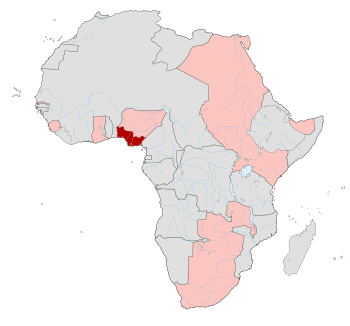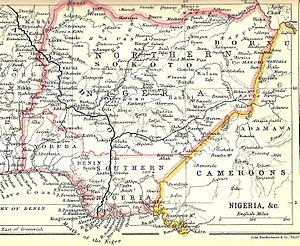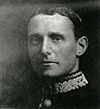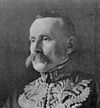Southern Nigeria Protectorate facts for kids
Quick facts for kids
Southern Nigeria Protectorate
|
|||||||||||||
|---|---|---|---|---|---|---|---|---|---|---|---|---|---|
| 1900–1914 | |||||||||||||
|
Anthem: God Save the Queen (1900-1901), God Save the King (1901-1914)
|
|||||||||||||

Southern Nigeria (red)
British possessions in Africa (pink) 1913 |
|||||||||||||
| Status | Protectorate of the British Empire | ||||||||||||
| Capital | Lagos (administrative centre from 1906) | ||||||||||||
| Common languages | English (official) Yoruba, Igbo, Ibibio, Edo, Ijaw languages widely spoken |
||||||||||||
| Religion | Christianity, Odinani, Yoruba religion, Islam, African traditional religion | ||||||||||||
| Government | Constitutional monarchy | ||||||||||||
| Monarch | |||||||||||||
|
• 1900–1901
|
Victoria | ||||||||||||
|
• 1901–1910
|
Edward VII | ||||||||||||
|
• 1910–1914
|
George V | ||||||||||||
| High Commissioner | |||||||||||||
|
• 1900–1904
|
Ralph Moor | ||||||||||||
|
• 1904–1906
|
Walter Egerton | ||||||||||||
| Governor | |||||||||||||
|
• 1906–1912
|
Walter Egerton | ||||||||||||
|
• 1912–1914
|
Frederick Lugard | ||||||||||||
| Historical era | New Imperialism | ||||||||||||
|
• Established
|
1 January 1900 | ||||||||||||
|
• Disestablished
|
1 January 1914 | ||||||||||||
| Currency | Pound sterling (1900–13) British West African pound (1913–14) |
||||||||||||
|
|||||||||||||
| Today part of | Nigeria | ||||||||||||
Southern Nigeria was a British-controlled area in what is now Nigeria. It was a "protectorate," meaning it was protected and controlled by the British Empire. This area was formed in 1900. It combined the Niger Coast Protectorate with lands managed by the Royal Niger Company near the Niger River.
In 1906, the Lagos colony was added to Southern Nigeria. The whole area was then called the Colony and Protectorate of Southern Nigeria. Later, in 1914, Southern Nigeria joined with the Northern Nigeria Protectorate. This created the single country of Nigeria. This merger happened mainly for economic reasons. The British wanted to use money earned in Southern Nigeria to help pay for things in Northern Nigeria.
Sir Frederick Lugard became the governor of both areas in 1912. He was in charge of bringing them together. He then became the first governor of the new, united Nigeria. Lugard set up important offices to help run the new country. A main office was created in Lagos, which was the capital. He also started the Nigerian Council. This group allowed people from different parts of the country to share their ideas.
Some services, like the military, money management, and railways, were combined for both Northern and Southern Nigeria. These were managed from Lagos. However, uniting the two regions was not easy. People in the North and South had different ideas about how to govern. Southern officials liked the idea of a bigger empire. But Northern officials worried that Southern ways would spread too much. People in the South also did not want Northern laws to apply to them.
Contents
Governing Southern Nigeria
Leaders and Changes
From the start, Southern Nigeria was led by a "High Commissioner." The first one was Ralph Moor. When Lagos joined Southern Nigeria in 1906, the High Commissioner, Walter Egerton, became the Governor.
In 1900, the British Foreign Office handed control of the protectorate to the Colonial Office. Ralph Moor became the High Commissioner. He set up the new government. He retired in 1903 due to poor health.
Walter Egerton became Governor of Lagos Colony in 1903. This area included most of the Yoruba lands. The Colonial Office wanted to combine Lagos with Southern Nigeria. So, in 1904, Egerton also became High Commissioner for Southern Nigeria. He held both jobs until 1906. Then, the two areas officially joined. Egerton became the Governor of the new Colony and Protectorate of Southern Nigeria. He stayed in this role until 1912.
In the new Southern Nigeria, the old Lagos Colony became the Western Province. The rest of Southern Nigeria was split into two parts. These were the Central Province, with its capital at Warri, and the Eastern Province, with its capital at Calabar.
When Egerton took over, a large part of southeast Nigeria was not yet under British control. He started sending out yearly "pacification patrols." These patrols usually got people to agree to British rule without needing to use force.
Egerton strongly supported building railways. He pushed for the railway from Lagos to Ibadan to be extended to Oshogbo. This project was approved in 1904 and finished in 1907. He believed railways were better than river transport. He also wanted the railway to go all the way to Kano through Zaria.
He also supported building many roads. His predecessor, Moor, had already created laws that allowed unpaid local workers to be used for this. Egerton agreed with Moor that local traders and those in Calabar were harming trade on the Cross River. He worked to change rules that stopped new traders from setting up inland.
Egerton was a big supporter of developing the colony. He believed in spending more money than was earned at certain times to help the colony grow. This was seen in his budgets from 1906 to 1912. He often had to fight with the Colonial Office to get his budgets approved.
By 1908, Egerton wanted a well-organized Agricultural Department. This department was created in 1910. He also supported rubber plantations, a type of farm he knew from his time in Malaya. He arranged for land to be rented for this. This started a very successful industry. He also thought the tin fields near Bauchi had great potential. He believed a railway line to these fields would be useful if they proved successful.
Egerton often disagreed with the leaders of Northern Nigeria. They argued about whether Ilorin should be part of Southern Nigeria. Ilorin was a Yoruba area, but its ruler was Muslim and had ties to the Uthmaniyya Caliphate in the North. They also argued about taxes on goods brought from the coast into Northern Nigeria. There were also disagreements about where railway lines from the North should end. Egerton argued against a line ending at Baro on the Niger River. This was because river travel to the coast from Baro was difficult and only possible during high water.
Egerton's government also brought in rules that separated Europeans and Africans. For example, Africans were not allowed in the West African Medical Service. It was also said that Europeans should not take orders from Africans. This meant African doctors could not serve in the army. Egerton himself did not always agree with these rules, and they were not always strictly followed.
The legal relationship between the Lagos government and the Yoruba states was unclear. It took until 1908 for Egerton to convince the Obas (rulers) to accept the Supreme Court in their main towns. In 1912, Frederick Lugard took over from Egerton. Lugard was made Governor-General of both Southern and Northern Nigeria. His main job was to unite the two areas. Egerton was then sent to British Guiana, which was seen as a step down. This might have been because of his disagreements with the Colonial Office.
Lugard returned to Nigeria to complete the merger into one colony. Many people in Lagos did not like this idea. But it did not cause much trouble in the rest of the country. From 1914 to 1919, Lugard was the Governor General of the new, combined Colony of Nigeria. During his time, Lugard worked hard to improve the lives of the local people. He tried to stop the sale of alcohol and end slave raiding and slavery. Lugard ran the country while spending half of each year in England. This meant his staff in Africa often had to wait for him to return to make important decisions. He based his rule on a military system.
| Name | Years in Office | Role | Picture |
|---|---|---|---|
| Sir Ralph Moor | 1900–1903 | High Commissioner of the Southern Nigeria Protectorate | |
| Sir Walter Egerton | 1903–1912 | High Commissioner of the Southern Nigeria Protectorate 1903–1906 Governor of the Colony and Protectorate of Southern Nigeria 1906–1912 |
|
| Sir Frederick Lugard | 1912–1914 | Governor of the Colony and Protectorate of Southern Nigeria |
Economy and Money
British Economic Ideas
At that time, the British believed that if African people adopted European ways, their resources could be used more effectively. They thought that if the slave trade stopped, chaos would disappear. Then, African efforts could focus on collecting natural products for Europe. It was believed that Africans alone could not keep enough order for this economic change. Only European rule, they thought, could do it.
However, just keeping order was not enough for the British. They also needed to encourage trade and growth. It was also a common idea that a colony's economic efforts should help, not compete with, the home country. This was an old idea from the "mercantilist" system.
| Year | Money Coming In (Revenue) | Money Going Out (Expenditure) | Left Over / Short |
|---|---|---|---|
| 1900 | 535,902 | 424,257 | +111,645 |
| 1901 | 606,431 | 564,818 | +41,613 |
| 1902 | 801,737 | 619,687 | +182,050 |
| 1903 | 760,230 | 757,953 | +2,277 |
| 1904 | 888,136 | 863,917 | +24,219 |
| 1905 | 951,748 | 998,564 | -46,816 |
| 1906 | 1,088,717 | 1,056,290 | +32,427 |
| 1907 | 1,459,554 | 1,217,336 | +242,218 |
| 1908 | 1,387,975 | 1,357,763 | +30,212 |
| 1909 | 1,361,891 | 1,648,648 | -286,793 |
| 1910 | 1,933,235 | 1,592,282 | +340,953 |
| 1911 | 1,956,176 | 1,717,259 | +238,917 |
| 1912 | 2,235,412 | 2,110,498 | +124,914 |
| 1913 | 2,668,198 | 2,096,311 | +571,887 |
More to Explore
- Postage stamps and postal history of the Southern Nigeria Protectorate
- Southern Nigeria Government Gazette







